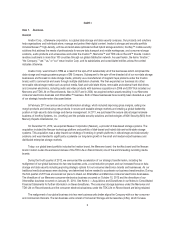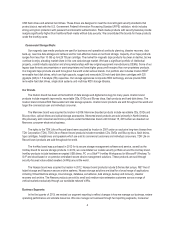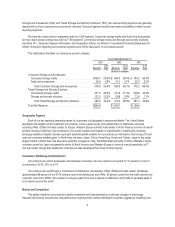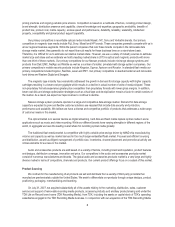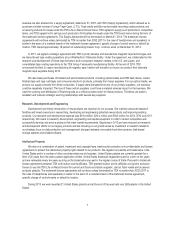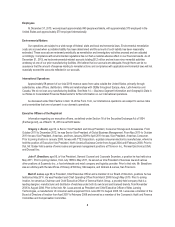Memorex 2013 Annual Report Download - page 14
Download and view the complete annual report
Please find page 14 of the 2013 Memorex annual report below. You can navigate through the pages in the report by either clicking on the pages listed below, or by using the keyword search tool below to find specific information within the annual report.statements of non-U.S. operating units are translated into U.S. dollars. Given that the majority of our revenues are non-U.S.
based, a strengthening of the U.S. dollar against other major foreign currencies could adversely affect our results of
operations. While these factors or the impact of these factors are difficult to predict, any one or more of them could adversely
affect our business, financial condition or operating results.
We use third-party contract manufacturing services and supplier-provided parts, components, and sub-
systems in our businesses and significant shortages, supplier capacity constraints, supplier production disruptions
or price increases could increase our operating costs and adversely impact the competitive positions of our
products. Our reliance on suppliers and third-party contract manufacturing to secure raw materials, parts and components
used in our products exposes us to volatility in the price and availability of these materials. In some instances, we depend
upon a single source of supply, manufacturing or assembly or participate in commodity markets that may be subject to
allocations by suppliers. A disruption in deliveries from our suppliers or third-party contract manufacturers, supplier capacity
constraints, supplier and third-party contract manufacturer production disruptions, price increases or decreased availability of
raw materials or commodities could have an adverse effect on our ability to meet our commitments to customers or increase
our operating costs. Additionally, we may experience changes in the supply and cost of raw materials and key components of
our products resulting from the effects of natural disasters. We believe that our supply management and production practices
are based on an appropriate balancing of the foreseeable risks and the costs of alternative practices. No assurances can be
given that acceptable cost levels will continue in the future. In addition, some critical raw materials and key components have
a limited number of suppliers. If we cannot obtain those raw materials or critical components from the suppliers, we will not be
able to produce certain products.
We may engage in business combinations that are dilutive to existing shareholders, result in unanticipated
accounting charges or otherwise harm our results of operations, and result in difficulties in assimilating and
integrating the operations, personnel, technologies, products and information systems of acquired companies or
businesses. We use financial assumptions and forecasts to determine the negotiated price we are willing to pay for an
acquisition. If those financial assumptions and/or forecasts are not accurate, the price we pay may be too high, resulting in an
inefficient use of cash and future goodwill impairment.
No assurance can be given that our previous or future acquisitions will be successful and will not materially adversely
affect our business, operating results, or financial condition. Failure to manage and successfully integrate acquisitions could
materially harm our business and operating results. Even when an acquired company has already developed and marketed
products, there can be no assurance that such products will be successful after the closing and will not cannibalize sales of
our existing products, that product enhancements will be made in a timely fashion or that pre-acquisition due diligence will
have identified all possible issues that might arise with respect to such company. Failed business combinations, or the efforts
to create a business combination, can also result in litigation.
Acquisitions may require capital infusions, typically entail many risks and could result in difficulties in assimilating and
integrating the operations, personnel, technologies, products and information systems of acquired companies. We may
experience delays in the timing and successful integration of acquired technologies and product development, unanticipated
costs and expenditures, changing relationships with customers, suppliers and strategic partners, or contractual, intellectual
property or employment issues. In addition, key personnel of an acquired company may decide not to work for us. The
acquisition of another company or its products and technologies may also result in our entering into a business market in
which we have little or no prior experience. These challenges could disrupt our ongoing business, distract our management
and employees, harm our reputation, subject us to an increased risk of intellectual property and other litigation and increase
our expenses. These challenges are magnified as the size of the acquisition increases, and we cannot ensure that we will
realize the intended benefits of any acquisition. Acquisitions may require large one-time charges and can result in contingent
liabilities, adverse tax consequences, substantial depreciation or deferred compensation charges, amortization of identifiable
purchased intangible assets or impairment of goodwill, any of which could have a material adverse effect on our business,
financial condition or results of operations.
We may incur asset impairment charges for intangible assets and goodwill in the future. We evaluate assets
on our balance sheet, including such intangible assets and goodwill, annually as of November 30th or whenever events or
11



